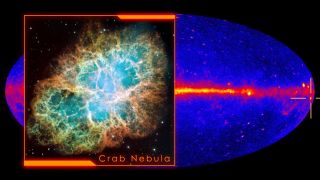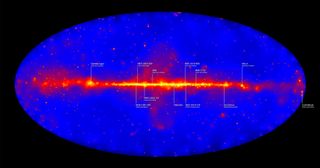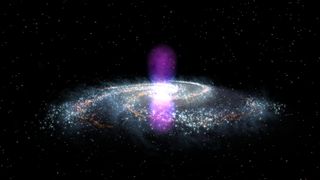
Happy birthday, Fermi! Top 5 highlights from 13 years of the gamma-ray telescope
The telescope began science operations on Aug. 4, 2008.

Paul M. Sutter is an astrophysicist at SUNY Stony Brook and the Flatiron Institute, host of "Ask a Spaceman" and "Space Radio," and author of "How to Die in Space." Sutter contributed this article to Space.com's Expert Voices: Op-Ed & Insights.
On Aug. 4, 2008, the Fermi Gamma-ray Space Telescope began full science operations, scanning the entire sky through the highest-energy form of light. In the past 13 years, Fermi has observed some of the most energetic and rare events in the entire cosmos, from flares raging on the sun to gigantic bubbles of plasma blasting out of our galaxy. Here are the top five highlights from this impressive telescope.
Related: Photos by NASA's Fermi Space Telescope
5) The Crab Nebula

In A.D. 1054, early astronomers were delighted and/or horrified to find a new, bright star appearing in the sky. They were witness to a supernova, the death of a massive star. Today, in that same patch of sky, located in the constellation Taurus, sits the Crab Nebula, the twisted and mangled wreckage of that once-great star.
The Crab Nebula is visible in backyard telescopes, but it isn't that impressive — just a faint, fuzzy patch that vaguely resembles a crab (if you squint hard enough).
But the gamma-rays reveal a lot of high-energy excitement in that millennium-old nebula. The Fermi telescope has observed multiple "superflares," brief bursts of intense gamma-ray emission, coming from the nebula. Astronomers suspect that a pulsar, the rapidly rotating core of the dead star, powers subatomic particles to superhigh energies, which then go on to knock things around and generate the gamma-ray burst.
4) Shortest gamma-ray burst
In fact, the Fermi telescope has become the go-to scientific instrument for observing gamma-ray bursts (GRBs) — brief, intense flashes of gamma-rays that come from all over the sky, indicating that most of them originate from outside the Milky Way. This includes a gamma-ray burst called GRB 081102B, which occurred in the direction of the constellation Boötes in 2008.
Get the Space.com Newsletter
Breaking space news, the latest updates on rocket launches, skywatching events and more!
GRB 081102B was the shortest gamma-ray burst ever recorded, lasting just one-tenth of a second. Usually, events at the cosmic scale take eons to play out, but this extreme cataclysm was over in less than a blink of an eye.
3) All-sky map

The Fermi telescope holds a privileged position: Because it orbits above Earth, it can easily and repeatedly scan the entire sky. This allows astronomers to not just capture one-off high-energy events but also get a sense of the general intensity of gamma-rays coming from all around us.
The Fermi all-sky map, updated every few years, is an example of that. The all-sky map revealed that our galaxy is a very strong emitter of gamma-rays, which are created when cosmic rays — tiny, high-energy particles — slam into the gas between the stars. The map also revealed the pockets of star-forming regions in our galaxy that generate gamma-rays, as well as the individual sources from outside the Milky Way.
2) Fermi Bubbles

The Fermi telescope revealed two massive plumes extending from each end of the Milky Way's core. Known as the Fermi Bubbles, these massive regions stretch some 25,000 light-years, making them almost the size of the galaxy itself.
Astronomers still aren't sure what's illuminating the bubbles and causing them to emit so much gamma-ray radiation. It could be that the supermassive black hole in the center of the Milky Way went through an intense feeding phase in the past few million years. Observations of other galaxies tell us that when black holes feed, some material escapes in the form of long, thin jets of plasma. Perhaps jets like those inflated these massive bubbles that remain today.
1) Kilonova
On Aug. 17, 2017, just over nine years into Fermi's mission, automated observing routines noticed the telltale flare of a gamma-ray burst in the direction of the galaxy NGC 4993, located 144 million light-years from Earth.
Within 3 seconds of that observation was another: the detection of gravitational waves rippling through Earth. The source of those gravitational waves came from the same direction in the sky.
In the span of a few hours, astronomers around the world trained their telescopes on the small galaxy, recording the first-ever known kilonova event — the merger of two neutron stars.
The co-discovery in gamma-rays and gravitational waves allowed for an exceptionally powerful look into this rare process, which previously had only been hypothesized. The observations confirmed many things: that neutron stars do collide, that when they collide they are about a thousand times brighter than a typical nova and that they release a flood of heavy elements to enrich the cosmos.
The close timing between the signals — the gamma-rays and gravitational waves arrived at Earth within 3 seconds of each other, despite having traveled for over 144 million years — also demonstrated that the gravitational force travels at the speed of light, cementing yet another aspect of Einstein's theory of general relativity.
Follow us on Twitter @Spacedotcom and on Facebook.
Join our Space Forums to keep talking space on the latest missions, night sky and more! And if you have a news tip, correction or comment, let us know at: community@space.com.

Paul M. Sutter is an astrophysicist at SUNY Stony Brook and the Flatiron Institute in New York City. Paul received his PhD in Physics from the University of Illinois at Urbana-Champaign in 2011, and spent three years at the Paris Institute of Astrophysics, followed by a research fellowship in Trieste, Italy, His research focuses on many diverse topics, from the emptiest regions of the universe to the earliest moments of the Big Bang to the hunt for the first stars. As an "Agent to the Stars," Paul has passionately engaged the public in science outreach for several years. He is the host of the popular "Ask a Spaceman!" podcast, author of "Your Place in the Universe" and "How to Die in Space" and he frequently appears on TV — including on The Weather Channel, for which he serves as Official Space Specialist.
